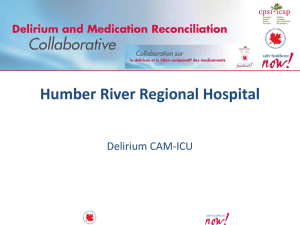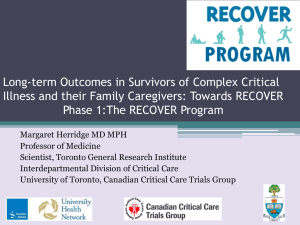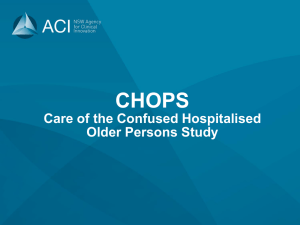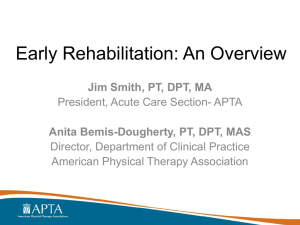to - SEDATION
advertisement
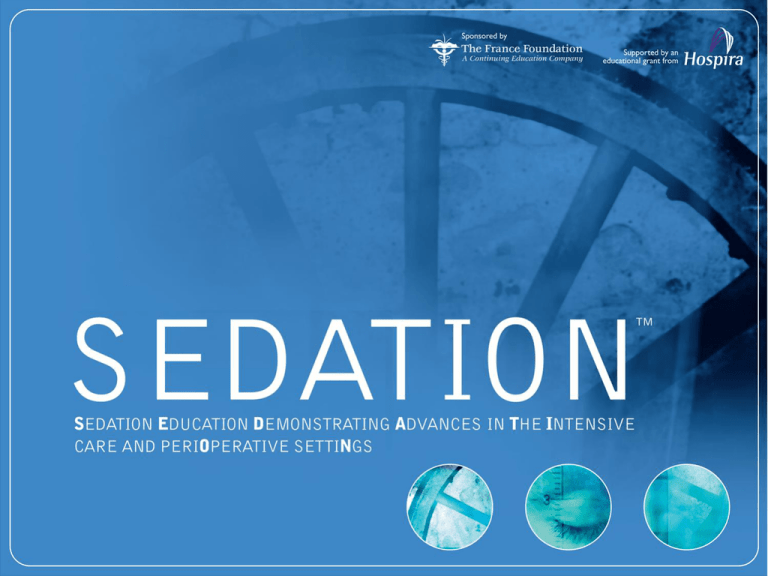
Learning Objectives • Manage adult patients who need sedation and analgesia while receiving ventilator support according to current standards and guidelines • Use validated scales for sedation, pain, agitation and delirium in the management of these critically ill patients • Assess recent clinical findings in pain, agitation, and delirium management and incorporate them into the management of ICU patients Reflect On Your Current Practice • • • • Are you familiar with the new PAD guidelines? Have you incorporated them into your practice? Are you targeting a light level of sedation? Do you use the ABCDE bundle or a similar structure at your institution? • What are the barriers to changing your practice? • What are the barriers to changing your system? Need for Sedation and Analgesia • • • • • Prevent pain and anxiety Decrease oxygen consumption Decrease the stress response Patient-ventilator synchrony Avoid adverse neurocognitive sequelae – – – – Depression PTSD Delirium Anxiety • Avoid post-intensive care syndrome Rotondi AJ, et al. Crit Care Med. 2002;30:746-752. Weinert C. Curr Opin in Crit Care. 2005;11:376-380. Kress JP, et al. Am J Respir Crit Care Med. 1996;153:1012-1018. A Word About the 2013 PAD Guidelines • Supporting organizations – American College of Critical Care Medicine (ACCM) – Society of Critical Care Medicine (SCCM) – American Society of Health-System Pharmacists (ASHP) • Some of this presentation is based on the guidelines • Guideline recommendations are evidence-based and will not apply to all patients • Intended as a roadmap for developing integrated, evidence-based, and patient-centered protocols Barr J, et al. Crit Care Med. 2013;41:263-306. What’s Different about this Version of the PAD Guidelines? Methods • GRADE measures quality and strength • Quality of Evidence: – Evaluation of the available data – High or low quality? – A (high), B (moderate), C (low) • Strength of Recommendation: – Confidence that following the recommendation will cause more good than harm (1 or 2) – Strong “We Recommend” – Weak “We Suggest” Grading of Recommendations Assessment, Development and Evaluation method http://www.gradeworkinggroup.org. Accessed March 2013. What’s Different About this Version of the PAD Guidelines? Results • Psychometric assessments comparing pain, sedation and delirium monitoring tools • More patient-centered, integrated and interdisciplinary approach to managing pain, agitation, and delirium – Far less emphasis on specific across-the-board pharmacologic recommendations • Greater emphasis on the pathophysiology, risks and management of delirium Barr J, et al. Crit Care Med. 2013;41:263-306. What’s Different About this Version of the PAD Guidelines? Scope • Far larger than the 2002 guidelines! – 2002 – 2008 – 2013 28 recommendations 36 recommendations (Surviving Sepsis Guidelines) 53 recommendations and statements • Not meant to be comprehensive – – – – Expect Variability Less Prescriptive More Proscriptive Strategies rather than agents • Result = a lot of flexibility – Pros – Cons • Expect variation (that is still compliant) Barr J, et al. Crit Care Med. 2013;41:263-306. What’s Different About this Version of the PAD Guidelines? Scope • Far larger than the 2002 guidelines! – 53 recommendations and statements vs 28 recommendations in 2002 vs 36 recommendations in the 2008 Surviving Sepsis Guidelines • Not meant to be comprehensive: – Addresses only questions of greatest importance to ICU clinicians – Some questions have no recommendations due to lack of research – Identifies areas for future research Barr J, et al. Crit Care Med. 2013;41:263-306. PAD Statements vs Recommendations Position Statements N 22 Type Descriptive Scored For Quality Quality Recommendations 32 A. High B. Moderate C. Low/very low Strength Example Delirium is associated with prolonged ICU and hospital LOS in adult ICU patients (A) A, B, C + For - Against Actionable Barr J, et al. Crit Care Med. 2013;41:263-306. Levels 1. Strong 2. Weak We recommend routine monitoring of delirium in adult ICU patients (+1B) Pain, Agitation, and Delirium Are Interrelated Delirium Barr J, et al. Crit Care Med. 2013;41:263-306. PAD Care Bundle TREAT ASSESS A PAIN AGITATION DELIRIUM Assess pain ≥ 4x/shift & prn Preferred pain assessment tools: • Patient able to self-report → NRS (0-10) • Unable to self-report → BPS (3-12) or CPOT (0-8) Patient is in significant pain if NRS ≥ 4, BPS > 5, or CPOT ≥ 3 Assess agitation, sedation ≥4x/shift & prn Preferred sedation assessment tools: • RASS (-5 to +4) or SAS (1 to 7) • NMD→ suggest using brain function monitoring Assess delirium Q shift & prn Preferred delirium assessment tools: • CAM-ICU (+ or -) • ICDSC (0 to 8) Depth of agitation, sedation defined as: • Agitated if RASS = +1 or +4, or SAS + 5 to 7 • Awake and calm if RASS = 0, or SAS = 4 • Lightly sedated if RASS = -1 to -2, or SAS = 3 • Deeply sedated if RASS = -3 to -5, or SAS = 1 to 2 Delirium present if: • CAM-ICU is positive • ICDSC ≥ 4 Treat pain within 30’ then reassess: • Non-pharmacologic treatment-relaxation therapy • Pharmacologic treatment: –Non-neuropathic pain → IV opioids +/- nonopioid analgesics –Neuropathic pain → gabapentin or carbamazepine, + IV opioids –S/p AAA repair, rib fractures → thoracic epidural Targeted sedation or DSI (Goal: patient purposely follows commands without agitation): RASS = -2-0, SAS = 3-4 • If under sedated (RASS > 0, SAS >4) assess/treat pain → treat w/sedatives prn • (non-benzodiazepine withdrawal is suspected) • If over sedated (RASS < -2, SAS < 3) hold sedatives until at target, then restart at 50% of previous dose • • • • • PREVENT • Administer pre-procedural analgesia and/or non-pharmacologic interventions (e.g., relaxation therapy) Treat pain first, then sedate Barr J, et al. Crit Care Med. 2013;41:263-306. • Consider daily SBT, early mobility and exercise when patients are at goal sedation level, unless contraindicated EEG monitoring if: – At risk for seizures – Burst suppression therapy is indicated for ↑ ICP • • • • • Treat pain as needed Reorient patients; familiarize surroundings; use patient’s eyeglasses, hearing aids if needed Pharmacologic treatment of delirium: – Avoid benzodiazepines unless ETOH or benzodiazepine withdrawal is suspected – Avoid rivastigmine – Avoid antipsychotics if ↑ risk of Torsades de pointes Identify delirium risk factors: dementia, HTN, ETOH abuse, high severity of illness, coma, benzodiazepine administration Avoid benzodiazepine use in those at ↑ risk for delirium Mobilize and exercise patients early Promote sleep (control light, noise; cluster patient care activities; decrease nocturnal stimuli) Restart baseline psychiatric meds, if indicated Pain, Agitation, and Delirium Are Interrelated Delirium Barr J, et al. Crit Care Med. 2013;41:263-306. PAD Pain Assessment Recommendations • We recommend that pain be routinely monitored in all adult ICU patients (+1B) • The BPS and the CPOT are the most valid and reliable behavioral pain scales for monitoring pain in adult ICU patients who are unable to self-report and in whom motor function is intact and behaviors are observable (B) • We do not suggest that vital signs be used alone for pain assessment in adult ICU patients (–2C) • We suggest that vital signs may be used as a cue to begin further assessment of pain (+2C) Barr J, et al. Crit Care Med. 2013;41:263-306. Assessing Pain • For patients able to self-report – Numeric Rating Scale – “On a scale of 0 to 10, how do you rate your current level of pain?” • For patients unable to self-report − Behavioral Pain Scale (BPS) − Critical Care Pain Observation Tool (CPOT) Barr J, et al. Crit Care Med. 2013;41:263-306. Payen JF, et al. Crit Care Med. 2001;29(12):2258-2263. Gélinas C, et al. Am J Crit Care. 2006;15:420-427. Behavioral Pain Scale (BPS) 3-12 Item Facial expression Upper limbs Compliance with ventilation Description Score Relaxed 1 Partially tightened (eg, brow lowering) 2 Fully tightened (eg, eyelid closing) 3 Grimacing 4 No movement 1 Partially bent 2 Fully bent with finger flexion 3 Permanently retracted 4 Tolerating movement 1 Coughing but tolerating ventilation for most of the time 2 Fighting ventilator 3 Unable to control ventilation 4 Payen JF, et al. Crit Care Med. 2001;29:2258-2263. Critical Care Pain Observation Tool Gélinas C, et al. Am J Crit Care. 2006;15:420-427. Assessing Pain Reduces Sedative/Hypnotic Use What proportion of MV ICU patients received sedative or hypnotic medication? Day 2 Pain Assessment? P value No (n = 631) Yes (n = 513) Any sedative 86 % 75 % < 0.01 Midazolam 65 % 57 % < 0.01 Propofol 21 % 17 % 0.06 Other 6% 4% 0.03 Payen JF, et al. Anesthesiology. 2009;111:1308-1316. Assessing Pain Associated With Improved Outcomes Outcome Day 2 Pain Assessment? Unadjusted OR P Adjusted OR P No Yes ICU Mortality 22% 19% 0.91 0.69 1.06 0.71 ICU LOS 18 d 13 d 1.70 < 0.01 1.43 0.04 MV duration 11 d 8d 1.87 < 0.01 1.40 0.05 Ventilator Acquired Pneumonia 24% 16% 0.61 < 0.01 0.75 0.21 Payen JF, et al. Anesthesiology. 2009;111:1308-1316. PAD Pain Management Recommendations • Preemptively treat chest tube removal with either analgesics and/or nonpharmacologic therapy (1C) • Suggest preemptively treating other types of procedural pain with analgesic and/or nonpharmacologic therapy (2C) • Use opioids as first-line therapy for treatment of non-neuropathic pain (1C) • Suggest using non-opioid analgesics in conjunction with opioids to reduce opioid requirements and opioid related side effects (2C) • Use gabapentin or carbamazepine, in addition to intravenous opioids, for treatment of neuropathic pain (1A) • Use thoracic epidural for postoperative analgesia in abdominal surgery patients (1B) • Suggest thoracic epidural analgesia be used for patients with traumatic rib fractures (2B) Barr J, et al. Crit Care Med. 2013;41:263-306. Pain, Agitation, and Delirium Are Interrelated Delirium Barr J, et al. Crit Care Med. 2013;41:263-306. PAD Agitation/Sedation Assessment Recommendations • Depth and quality of sedation should be routinely assessed in all ICU patients (1B) • The RASS and SASS are the most valid and reliable scales for assessing quality and depth of sedation in ICU patients (B) • Suggest using objective measures of brain function to adjunctively monitor sedation in patients receiving neuromuscular blocking agents (2B) • Use EEG monitoring either to monitor non-convulsive seizure activity in ICU patients at risk for seizures, or to titrate electrosuppressive medication to achieve burst suppression in ICU patients with elevated intracranial pressure (1A) Barr J, et al. Crit Care Med. 2013;41:263-306. Sedation-Agitation Scale (SAS) Score State Behaviors 7 Dangerous Agitation 6 Very Agitated 5 Agitated 4 Calm and Cooperative 3 Sedated Difficult to arouse, awakens to verbal stimuli or gentle shaking but drifts off 2 Very Sedated Arouses to physical stimuli but does not communicate or follow commands 1 Unarousable Minimal or no response to noxious stimuli, does not communicate or follow commands Pulling at ET tube, climbing over bedrail, striking at staff, thrashing side-to-side Does not calm despite frequent verbal reminding, requires physical restraints Anxious or mildly agitated, attempting to sit up, calms down to verbal instructions Calm, awakens easily, follows commands Riker RR, et al. Crit Care Med. 1999;27:1325-1329. Brandl K, et al. Pharmacotherapy. 2001;21:431-436. Richmond Agitation Sedation Scale (RASS) Sessler CN, et al. Am J Respir Crit Care Med. 2002;166(10):1338-1344. PAD Depth of Sedation Statements • Maintaining light levels of sedation in adult ICU patients is associated with improved clinical outcomes (eg, shorter duration of mechanical ventilation and a shorter ICU length of stay [LOS]) (B) • Maintaining light levels of sedation increases the physiologic stress response, but is not associated with an increased incidence of myocardial ischemia (B) • The association between depth of sedation and psychological stress in these patients remains unclear (C) Barr J, et al. Crit Care Med. 2013;41:263-306. PAD Depth of Sedation Recommendations • We recommend that sedative medications be titrated to maintain a light rather than a deep level of sedation in adult ICU patients, unless clinically contraindicated (+1B) • We recommend either daily sedation interruption or a light target level of sedation be routinely used in mechanically ventilated adult ICU patients (+1B) Barr J, et al. Crit Care Med. 2013;41:263-306. Early Deep Sedation Survival Fraction Intubated Longer MV and Reduced 6 Month-Survival Shehabi Y, et al. Am J Respir Crit Care Med. 2012;186(8):724-731. Mental Health After Light or Deep Sedation • Patients: adults requiring mechanical ventilation • Sedation with midazolam – Light: Ramsay 1-2, intermittent injection – Deep: Ramsay 3-4, continuous infusion • Results – Primary endpoints (4 weeks after ICU discharge) Trend towards more PTSD symptoms with deep sedation No difference in anxiety or depression scores – Other endpoints: light sedation patients averaged 1 day shorter on MV (P = 0.03) 1.5 days shorter LOS (P = 0.03) Treggiari MM, et al. Crit Care Med. 2009;37(9):2527-2534. Daily Sedation Interruption Decreases Duration of Mechanical Ventilation • Hold sedation infusion until patient awake and then restart at 50% of the prior dose • “Awake” defined as any 3 of the following: – Open eyes in response to voice – Use eyes to follow investigator on request – Squeeze hand on request – Stick out tongue on request • Fewer diagnostic tests to assess changes in mental status • No increase in rate of agitated-related complications or episodes of patient-initiated device removal • No increase in PTSD or cardiac ischemia Kress JP, et al. N Engl J Med. 2000;342:1471-1477. Needham DM, et al. Crit Care Med. 2012;40(2):502-509 ABC Trial To determine the efficacy and safety of a protocol linking: spontaneous awakening trials (SATs) & spontaneous breathing trials (SBTs) Girard TD, et al. Lancet. 2008;371:126-134. ABC Trial: Main Outcomes Outcome* SBT SAT+SBT P-value 12 15 0.02 Successful extubation, days 7.0 5 0.05 ICU discharge, days 13 9 0.02 Hospital discharge, days 19 15 0.04 97 (58%) 74 (44%) 0.01 Coma 3.0 2.0 0.002 Delirium 2.0 2.0 0.50 Ventilator-free days Time-to-Event, days Death at 1 year, n (%) Days of brain dysfunction *Median, except as noted Girard TD, et al. Lancet. 2008;371:126-134. ABC Trial: 1 Year Mortality Girard TD, et al. Lancet. 2008;371:126-134. SAT Protocol SBT Protocol Protocol + SAT/SBT versus Protocol + SBT Alone Mehta S, et al. JAMA. 2012;308(19):1985-1992. Nursing-Implemented Sedation Protocol: Barnes Jewish Pilot United States 25 P < 0.001 Protocol n = 162 Routine n = 159 Significant patient characteristics/metrics/outcomes Protocol Routine P value CIVS† 66 (40) 66 (42) 0.9 Duration CIVS, hrs* 3.5 ± 4 5.6 ± 6.4 0.003 Bolus† 118 (72) 127 (80) 0.14 Reintubated† 14 (8.6) 21 (13) 0.2 Trached† 10 (6.2) 21 (13.2) 0.04 20 Median Time (days) 20 14 15 P = 0.13 10 P = 0.003 4.8 5 7.5 5.7 *Data presented in median; †Data presented as n (%) CIVS: continuous intravenous infusion sedation 2.3 0 Duration of MV ICU LOS Hospital LOS Single center, prospective, trial of 332 consecutive ICU patients requiring mechanical ventilation randomized to protocolized sedation (n = 162) or routine care (n = 159) at Barnes Jewish Hospital from 8/97 to 7/98. Protocol used goal orientated sedation to target Ramsey with bolus requirements before initiation of continuous infusion and uptitration of opioids and benzodiazepines. Brook AD, et al. Crit Care Med. 1999;27(12):2609-2615. Nursing-Implemented Sedation Protocol: Bocage University Hospital France 25 Significant patient characteristics/metrics/outcomes Protocol n = 197 P = 0.003 21 Control n = 226 Protocol Control P value Daily midazolam, mg* 44 ± 31 92 ± 59 0.001 Duration midazolam, hrs** 3 5 0.18 Reintubated† 11 (6) 29 (13) 0.01 VAP diagnosis† 12 (6) 34 (15) 0.005 Median Time (days) 20 17 P = 0.004 15 11 P = 0.001 10 5 8 4.2 *Data presented in mean; ** Data presented in median †Data presented as n (%) 5 0 Duration of MV ICU LOS Hospital LOS Single center, prospective, before-after trial of 423 ICU patients requiring mechanical ventilation for > 48 hours before (n = 226) and after (n = 197) implementation of sedation protocol at Bocage University Hospital from 5/99 to 12/03. Protocol used goal orientated sedation to target Q3hr Cambridge scale with bolus requirements before initiation of continuous infusion and uptitration of midazolam Quenot JP, et al. Crit Care Med. 2007;35(9):2031-2036. Pharmacist Enforced Adherence to an ICU Sedation Guideline: Boston Medical Center MICU 25 RPh intervention n = 78 P = 0.001 Significant patient characteristics/metrics/outcomes Control n = 78 19.8 Median Time (days) 20 RPh Control P value 15 (19.2) 6 (7.7) 0.03 Lorazepam equivalents/vent day, mg* 65.2 ± 114.1 74.8 ± 76.1 0.54 Fentanyl equivalents/vent day, mcg* 102.5 ± 328 400 ± 1026 0.02 Alcohol/drug overdose† P = 0.002 15 P = 0.0004 11.8 10.6 8.9 10 7 5.3 *Data presented in mean ; †Data presented as n (%) 5 0 Duration of MV ICU LOS Hospital LOS Single center trial of 156 adult MICU patients requiring mechanical ventilation before (n = 78) and after (n = 78) implementation of RPh enforced guideline sedation management at Boston Medical Center. Guideline addressed use of agent selection, goal oriented therapy, and dose limitation strategies. Marshall J, et al. Crit Care Med. 2008;36(2):427-433. PAD Choice of Sedative Recommendations • We suggest that analgesia-first sedation be used in mechanically ventilated adult ICU patients (+2B) • We suggest that sedation strategies using nonbenzodiazepine sedatives (either propofol or dexmedetomidine) may be preferred over sedation with benzodiazepines (either midazolam or lorazepam) to improve clinical outcomes in mechanically ventilated adult ICU patients (+2B) • We suggest that in adult ICU patients with delirium unrelated to alcohol or benzodiazepine withdrawal, continuous IV infusions of dexmedetomidine rather than benzodiazepine infusions be administered for sedation to reduce the duration of delirium in these patients (+2B) Barr J, et al. Crit Care Med. 2013;41:263-306. Analgosedation • Analgesic first (A-1), supplement with sedative • Acknowledges that discomfort may cause agitation • Remifentanil-based regimen – Reduces propofol use – Reduces median MV time – Improves sedation-agitation scores • Not appropriate for drug or alcohol withdrawal Park G, et al. Br J Anaesth. 2007;98:76-82. Rozendaal FW, et al. Intensive Care Med. 2009;35:291-298. Analgosedation • 140 critically ill adult patients undergoing mechanical ventilation in single center • Randomized, open-label trial – Both groups received bolus morphine (2.5 or 5 mg) – Group 1: No sedation (n = 70 patients) - morphine prn – Group 2: Sedation (20 mg/mL propofol for 48 h, 1 mg/mL midazolam thereafter) with daily interruption until awake (n = 70, control group) • Endpoints – Primary Number of days without mechanical ventilation in a 28-day period – Other Length of stay in ICU (admission to 28 days) Length of stay in hospital (admission to 90 days) Strøm T, et al. Lancet. 2010;375:475-480. Analgosedation Results • Patients receiving no sedation had – – – – More days without ventilation (13.8 vs 9.6 days, P = 0.02) Shorter stay in ICU (HR 1.86, P = 0.03) Shorter stay in hospital (HR 3.57, P = 0.004) More agitated delirium (N = 11, 20% vs N = 4, 7%, P = 0.04) • No differences found in – Accidental extubations – Need for CT or MRI – Ventilator-associated pneumonia Strøm T, et al. Lancet. 2010;375:475-480. Benzodiazepines vs Propofol Better Outcomes With Propofol Study/Year Grounds et al 1987 Population Cardiac surgery Outcome Improved Faster awakening Aitkenhead et al 1989 General ICU More consistent awakening, faster weaning McMurray et al 1990 Cardiac surgery Carrasco et al 1993 General ICU Faster awakening More accurate sedation, faster awakening, lower costs Roekaerts et al 1993 Cardiac surgery Faster awakening, earlier extubation Ronan et al 1995 Surgical ICU Faster awakening Sherry et al 1996 Cardiac surgery Lower costs Chamorro et al 1996 General ICU Better ventilator synchrony, faster awakening Barrientos-Vega et al 1997 General ICU Earlier extubation Weinbroum et al 1997 Sanchez-Izquierdo-Riera et al 1998 McCollam et al 1999 General ICU Faster awakening Trauma ICU Faster awakening Trauma ICU Less oversedation Mixed ICU More accurate sedation, earlier extubation Medical ICU Fewer ventilator days Hall et al 2001 Carson et al 2006 Ely EW, et al. Chest. 2012;142(2);287-289. Benzodiazepines vs Propofol Study/Year Population Outcome Improved Searle et al/1997 Cardiac surgery None Kress et al/2000 Medical ICU None Cardiac surgery None … … Trials finding no differences in outcomes Huey-Ling et al/2008 Trials finding better outcomes with BZD None Ely EW, et al. Chest. 2012;142(2);287-289. Benzodiazepines vs Dexmedetomidine Study/Year Population Outcome Improved Trials finding better outcomes with dex Pandharipande et al/2007 Mixed ICU Riker et al/2009 Mixed ICU Ruokonen et al/2009 Mixed ICU Maldonado et al/2009 Cardiac surgery Esmaoglu et al/2009 Eclampsia Dasta et al/2010 Mixed ICU Jakob et al/2012 General ICU More accurate sedation, more delirium/coma-free days Lower prevalence of delirium, earlier extubation Shorter duration of mechanical ventilation Lower incidence and duration of delirium Shorter ICU length of stay Lower ICU costs Lighter sedation, fewer ventilation days Trials finding no differences in outcomes None … … … … Trials finding better outcomes with the BZD None Ely EW, et al. Chest. 2012;142(2);287-289. MENDS: Dexmedetomidine vs Lorazepam • Double-blind RCT of dex (0.15–1.5 mcg/kg/hr) vs lorazepam (1–10 mg/hr) • Titrated to sedation goal (using RASS) established by ICU team • Dexmedetomidine resulted in more time spent within sedation goals than lorazepam (P = 0.04). Differences in 28-day mortality and delirium-free days were not significant • While incidence of HR ≤ 60 was greater with Dex (17 vs 4%, P = 0.03, the incidence of HR ≤ 40 was not different (2 vs 2%) Pandharipande PP, et al. JAMA. 2007;298(22) 2644-2653. SEDCOM: Dexmedetomidine vs Midazolam • Double-blind, randomized, multicenter trial comparing long-term (> 24 hr) dexmedetomidine (n = 244) with midazolam (n = 122) • Sedatives (DEX 0.2-1.4 μg/kg/hr or MDZ 0.02-0.1 mg/kg/hr) titrated for light sedation (RASS -2 to +1), administered up to 30 days • All patients underwent daily arousal assessments and drug titration Q 4 hours Midazolam (N = 122) DEX (N = 244) PValue Time in target sedation range, % 75.1 77.3 0.18 Duration of sedation, days 4.1 3.5 0.01 Time to extubation, days 5.6 3.7 0.01 Patients receiving open-label, % midazolam 49 63 0.02 18.9 42.2 0.001 0.8 4.9 0.07 Outcome Bradycardia, % Bradycardia requiring intervention, % Riker RR, et al. JAMA. 2009;301(5):489-499. MIDEX and PRODEX Trials MIDEX PRODEX • 2 phase 3 multicenter RCTs • Dexmedetomidine vs midazolam (MDZ) or propofol • ~ 250 patients per arm, MV > 24 hours • Daily interruption of sedation, SBT Arm Time at RASS Target Median MV, h ICU LOS, h Arousability (total VAS) Hypo tension Brady cardia MDZ 56.6% 164 243 30.0 11.6% 5.2 Dex 60.7% 123 211 49.7 20.6% 14.2 P-value 0.15 0.03 < 0.001 0.007 < 0.001 Propofol 64.7% 118 185 40.1 13.4% 10.1% Dex 64.6% 97 164 51.3 13.0% 13% 0.97 0.24 P-value Jakob SM, et al. JAMA. 2012;307:1151-1160. < 0.001 Pain, Agitation, and Delirium Are Interrelated Delirium Barr J, et al. Crit Care Med. 2013;41:263-306. Cardinal Symptoms of Delirium and Coma Morandi A, et al. Intensive Care Med. 2008;34:1907-1915. ICU Delirium • Develops in ~2/3 of critically ill patients • Hypoactive or mixed forms most common • Increased risk – Benzodiazepines – Extended ventilation – Immobility • Associated with weakness • Undiagnosed in up to 72% of cases Vasilevskis EE, et al. Chest. 2010;138(5):1224-1233. Sequelae of Delirium During the ICU/Hospital Stay After Hospital Discharge • Increased mortality • Longer intubation time • Average 10 additional days in hospital • Higher costs of care • Increased mortality • Development of dementia • Long-term cognitive impairment • Requirement for care in chronic care facility • Decreased functional status at 6 months Bruno JJ, Warren ML. Crit Care Nurs Clin North Am. 2010;22(2):161-178. Shehabi Y, et al. Crit Care Med. 2010;38(12):2311-2318. Rockwood K, et al. Age Ageing. 1999;28(6):551-556. Jackson JC, et al. Neuropsychol Rev. 2004;14:87-98. Nelson JE, et al. Arch Intern Med. 2006;166:1993-1999. Delirium Duration and Mortality Kaplan-Meier Survival Curve P < 0.001 Each day of delirium in the ICU increases the hazard of mortality by 10% Pisani MA. Am J Respir Crit Care Med. 2009;180:1092-1097. Delirium After Stroke • • • Increased 12-month mortality risk Stroke patients +/- delirium Will delirium treatment change outcome? Shi Q, et al. Stroke. 2012;43(3):645-649. Worse Long-term Cognitive Performance • Duration of delirium was an independent predictor of cognitive impairment – An increase from 1 day of delirium to 5 days was associated with nearly a 5-point decline in cognitive battery scores • Patient testimony “One quite literally loses one’s grip on what is true and what is false because the true and the false are mixed together in a mess of experience.” Girard TD, et al. Crit Care Med. 2010;38:1513-1520. Misak CJ. Am J Respir Crit Care Med. 2004;170(4):357-359. PAD Delirium Assessment Statements • In adult ICU patients, delirium is associated with – Increased mortality (A) – Prolonged ICU and hospital LOS (A) – Development of post-ICU cognitive impairment (B) • Routine monitoring of delirium in adult ICU patients is feasible in clinical practice (B) Barr J, et al. Crit Care Med. 2013;41:263-306. PAD Delirium Assessment Recommendations • We recommend routine monitoring of delirium in adult ICU patients (+1B) • The CAM-ICU and the ICDSC are the most valid and reliable delirium monitoring tools in adult ICU patients (A) Barr J, et al. Crit Care Med. 2013;41:263-306. Confusion Assessment Method (CAM-ICU) Ely EW, et al. Crit Care Med. 2001;29:1370-1379. Ely EW, et al. JAMA. 2001;286:2703-2710. http://www.mc.vanderbilt.edu/icudelirium/assessment.html. Accessed January 2013. Intensive Care Delirium Screening Checklist 1. Altered level of consciousness 2. Inattention 3. Disorientation 4. Hallucinations 5. Psychomotor agitation or retardation 6. Inappropriate speech 7. Sleep/wake cycle disturbances 8. Symptom fluctuation Score 1 point for each component present during shift • Score of 1-3 = Subsyndromal Delirium • Score of ≥ 4 = Delirium Bergeron N, et al. Intensive Care Med. 2001;27:859-864. Ouimet S, et al. Intensive Care Med. 2007;33:1007-1013. Pediatric CAM-ICU 146 paired assessments Mean age = 12.2 years 2 critical care clinicians vs. pediatric psychiatrist Sensitivity = 83% (95% CI, 66-93%) Specificity = 99% (95% CI, 95-100%) Inter-rater reliability κ = 0.96 Smith HA, et al. Crit Care Med. 2011;39(1):150-157. PAD Treatment of Delirium Recommendations • There is no published evidence that treatment with haloperidol reduces the duration of delirium in adult ICU patients (No evidence) • Atypical antipsychotics may reduce the duration of delirium in adult ICU patients (C) • We do not recommend administering rivastigmine to reduce the duration of delirium in ICU patients (–1B) Barr J, et al. Crit Care Med. 2013;41:263-306. Quetiapine vs. Placebo Delirium + Haloperidol PRN Quetiapine (n = 18) • • • • • • Placebo (n = 18) Randomized, double-blind, placebo-controlled Multisite (3 centers) 36 ICU patients PO delivery of study drug Quetiapine dose: 50-200 mg q12h Primary outcome: time to first resolution of delirium (ie, first 12-hour period when ICDSC ≤ 3) Devlin JW, et al. Crit Care Med. 2010;38(2):419-427. Proportion of Patients with Delirium Patients with First Resolution of Delirium Log-Rank P = 0.001 Placebo Quetiapine Day During Study Drug Administration Quetiapine added to as-needed haloperidol results in faster delirium resolution, less agitation, and a greater rate of transfer to home or rehabilitation. Devlin JW, et al. Crit Care Med. 2010;38:419-427. The MIND Study Haloperidol Ziprasidone n = 35 • • • • • • Placebo n = 32 Modifying the INcidence of Delirium (MIND) Randomized and double-blind Multisite (6 centers) 103 MV patients PO/IM delivery of study drug Doses – Haloperidol – Ziprasidone 5-20 mg 40-160 mg Girard TD, et al. Crit Care Med. 2010;38(2):428-437. n = 36 MIND Study Results Haloperidol (n = 35) Ziprasidone (n = 32) Placebo (n = 36) P Delirium/coma-free days 14 [6-18] 15 [9-18] 12.5 [2-17] 0.66 Ventilator-free days 8 [0-15] 12 [0-19] 12 [0-23] 0.25 12 [5-16] 10 [4-14] 7 [5-12] 0.70 14 [9-NA†] 14 [9-NA†] 15 [9-NA†] 0.68 11 13 17 0.81 0 [0-0.2] 0 [0-0] 0 [0-0] 0.56 27 [25-31] 28 [24-35] 33 [23-36] 0.50 Outcome* Length of stay ICU Hospital Mortality, % Extrapyramidal side effects Daily EPS score Cognition at discharge Mean T-score *Median [interquartile range] except as noted Girard TD, et al. Crit Care Med. 2010;38(2):428-437. Haloperidol Prophylaxis • Patients – Predicted risk for delirium of ≥ 50% – History of alcohol abuse or dementia • Treatment – Haloperidol 1 mg/8 hrs – Historical and parallel controls • Endpoints – Delirium incidence – Delirium free days without coma – 28-day mortality van den Boogaard M, et al. Crit Care. 2013;17(1):R9. n = 177 n = 299 Haloperidol Prophylaxis van den Boogaard M, et al. Crit Care. 2013;17(1):R9. Haloperidol Prophylaxis: Survival van den Boogaard M, et al. Crit Care. 2013;17(1):R9. Haloperidol Prophylaxis Decreases Delirium All Daily Prevalence of Delirium, (%) Haloperidol Cumulative % Incidence of Delirium, (%) Type of Surgery IntraOthers Abdominal Placebo Log-rank P = 0.021 Time to Onset of Delirium, days Haloperidol Placebo Age APACHE-2 Intubated (%) Days After Surgery Wang W, et al. Crit Care Med. 2012;40:812-820. Haloperidol (n = 229) Placebo (n = 228) Pvalue 74.0 ± 5.8 74.4 ± 7.0 0.50 8.7± 3.0 8.6 ± 2.8 0.58 78.6 77.6 0.80 Rivastigmine for Delirium? Survival (%) • FDA approved for dementia of Alzheimer’s or Parkinson’s • Cholinesterase inhibitor • Result − Mortality (vs placebo): 22% vs 8%, P = 0.07 − Delirium (vs placebo): 5 vs 3 days, P = 0.06 • Conclusion: Time (days after inclusion) − Need RCTs for delirium as endpoint − Don’t use rivastigmine for ICU delirium http://www.accessdata.fda.gov. Accessed March 2013. Van Eijk MM, et al. Lancet. 2010;376(9755):1829-1837. PAD Management of Delirium Recommendation • We recommend performing early mobilization of adult ICU patients whenever feasible to reduce the incidence and duration of delirium (+1B) Barr J, et al. Crit Care Med. 2013;41:263-306. Early Mobilization Trial Design • 104 sedated patients with daily interruption – Early exercise and mobilization (PT & OT; intervention; n = 49) – PT & OT as ordered by the primary care team (control; n = 55) • Primary endpoint: number of patients returning to independent functional status at hospital discharge – Ability to perform 6 activities of daily living – Ability to walk independently • Assessors blinded to treatment assignment • Secondary endpoints – Number of hospital days with delirium – Ventilator-free days during the first 28 days of hospital stay – Length of stay in the ICU and in hospital Schweickert WD, et al. Lancet. 2009;373:1874-1882. Perform Safety Screen First • • • • • • Patient responds to verbal stimulation (ie, RASS ≥ -3)* FIO2 ≤ 0.6 PEEP ≤ 10 cmH2O No dose of any vasopressor infusion for at least 2 hours No evidence of active myocardial ischemia (24 hrs) No arrhythmia requiring the administration of new antiarrhythmic agent (24 hrs) Pass Exercise/Mobility Therapy Schweickert WD, et al. Lancet. 2009;373:1874-1882. Fail Too Ill for Exercise/Mobility *Range of motion may be started in comatose patients, but not considered Early Exercise/Mobility Early Mobilization Protocol: Result • Return to independent functional status at discharge – 59% in intervention group – 35% in control group (P = 0.02) Schweickert WD, et al. Lancet. 2009;373:1874-1882. Early PT and OT in Mechanically Ventilated ICU Patients All Patients 16 14 Median Time (days) P = 0.93 PT/OT with DSI n = 49 DSI alone n = 55 13.5 12 P = 0.08 10 8 P = 0.02 7.9 P = 0.02 6.1 6 4 4 2 12.9 5.9 3.4 2 0 Duration of ICU Delirium Mechanical Ventilation Schweickert WD, et al. Lancet. 2009;373(9678):1874-1882. ICU LOS Hospital LOS Protocol for Early Mobility Therapy Acute Respiratory Failure Patients Morris PE, et al. Crit Care Med. 2008;36(8):2238-2243. Early Mobility Therapy Results Primary Endpoint: more protocol patients received PT than did usual care (80% vs. 47%, P ≤ 0.001) Usual Care* (n = 135) Protocol* (n = 145) P-Value Days to first out of bed 11.3 5.0 0.001 Ventilator days 10.2 8.8 0.163 ICU LOS days 6.9 5.5 0.025 Hospital LOS days 14.5 11.2 0.006 *Values adjusted for BMI, Acute Physiology and Chronic Health Evaluation II, and vasopressors Morris PE, et al. Crit Care Med. 2008;36(8):2238-2243. Helpful Approach to Delirium Management 1. Stop 2. THINK 3. Lastly medicate Stop and THINK Do any meds need to be stopped or lowered? • Especially consider sedatives Toxic Situations • Is patient on minimal amount necessary? Hypoxemia Infection/sepsis (nosocomial) Immobilization Nonpharm interventions – Daily sedation cessation – Targeted sedation plan • Do sedatives need to be changed? • CHF, shock, dehydration • Deliriogenic meds (tight titration) • New organ failure (liver/kidney) • Hearing aids, glasses, reorient, sleep protocols, music, noise control, ambulation K+ or electrolyte problems PAD Team Recommendation • We recommend using an interdisciplinary ICU team approach that includes provider education, pre-printed and/or computerized protocols and order forms, and quality ICU rounds checklists to facilitate the use of pain, agitation, and delirium management guidelines or protocols in adult ICUs (+1B) Barr J, et al. Crit Care Med. 2013;41:263-306. PAD Interdisciplinary Team Pharmacy Champion Physical Therapy Champion RT Champion Hospital Administrators RN Champion MD Champion Courtesy J Barr, MD Family Integrated Approach to PAD Patient Introducing ABCDE in the ICU: Practical Advice for Implementing Protocols ABCDE Bundle Morandi A, et al. Curr Opin Crit Care. 2011;17:43-49. What Is the ABCDE Bundle? We Need Coordinated Care • Many tasks and demands on critical care staff • Great need to align and support the people, processes, and technology already in ICUs • ABCDE bundle is multicomponent, interdependent, and designed to: – Improve clinical team collaboration – Standardize care processes – Break the cycle of oversedation and prolonged ventilation Vasilevskis EE, et al. Chest. 2010;138(5):1224-1233. Awake and Breathing Coordination ↓ Duration of mechanical ventilation ↓ Duration of coma ↓ Mortality Choose light sedation & avoid benzos ↓ Duration of mechanical ventilation ↓ Mortality ↓ Delirium Delirium screening ↓ Delirium detection Early Mobility & Environment ↓ Duration of delirium ↓ Disability ↓ ICU Length of Stay ↓ Rehospitalization/Mortality Morandi A, et al. Curr Opin Crit Care. 2011;17(1):43-49. Vasilevskis EE, et al. Crit Care Med. 2010;38(10 Suppl):S683-691. Vasilevskis EE, et al. Chest. 2010;138(5):1224-1233. The PAD Road Map A Script for Reporting Pain, Agitation and Delirium in Multidisciplinary Rounds Investigate Where is the patient going? Where is the patient now? How did we get there? Discussion Points Report Target scores: • Agitation/Sedation • Pain Level (some chronic pain patients may never be pain free) Current assessment scores: • Pain: NRS/CPOT/BPS • Agitation/Sedation: RASS/SAS • Delirium: CAM-ICU/ICDSC List medications patient is currently receiving or has received in the past shift for pain, agitation and delirium. • • • Do the goals need to be adjusted? Do these assessments represent any change in the patient’s underlying pathology/illness? Do any medications need discontinued or reduced? Do any medications need to be started? Balas MC, et al. Crit Care Nurse. 2012;32:35-47. General Barriers to Changing the ICU Culture • Tendency to maintain the status quo • Resistance of independent groups to alter their behaviors and relinquish some autonomy • Perceived disproportionality of outcomes from the proposed change to the efforts required for change • Lack of significant prioritization • Insufficient personal accountability for completing change • Inadequate knowledge about clinical outcomes Hatler CW, et al. Am J Crit Care. 2006;15:549-555. Quality Improvement Project: Implementing ABCDE • Multidisciplinary team focused on reducing heavy sedation, using SAT-SBT protocol and increasing MICU staffing to include full-time physical and occupational therapists with new consultation guidelines • Results: – – – – – Delirium decreased Sedation use decreased Physical mobility improvement Decrease hospital length of stay Increased MICU admissions Needham DM, et al. Arch Phys Med Rehabil. 2010;91(4):536-542. Needham DM, et al. Top Stroke Rehabil. 2010;17(4):271-281. QI Program for Changing the ICU Culture Summarize the Evidence Identify Local Barriers to Implementation Measure Performance Ensure All Patients Receive the Interventions Needham DM, et al. Top Stroke Rehabil. 2010;17(4):271-281. Key Steps for Effective Change • Linking effective care processes with hospital and long-term patient outcomes • Creating a strategy to improve teamwork and collaboration • Creating a process for early mobilization • Recognizing that current practice patterns may interfere with mobility • Agreeing on a need to change • Identification of a local champion Wheelan SA, et al. Am J Crit Care. 2003;12:527-534. Durbin CG. Crit Care Med. 2006;34(3 Suppl):S12-S17. Closing the Gap Between the PAD Guidelines and ICU Practice • Multifaceted, interdisciplinary approach • Adapt to local practice patterns and resource availability – Institution-specific protocols and order sets • • • • • • • Education Engagement of local thought leaders Point-of-use reminders Decision-support tools Caregiver-specific practice feedback Continuous protocol evaluation and modification Integration into electronic information systems Barr J, et al. Crit Care Med. 2013;41:263-306. Conclusions • PAD guidelines provide evidence-based statements and recommendations • Use validated scales to assess pain, agitation, and delirium in the ICU • Analgosedation has been shown to improve outcomes; consider sedation only if necessary Conclusions • Target a light level of sedation • Titrate all sedative medications using a validated assessment tool to keep patients comfortable and arousable if possible • Use of benzodiazepines should be minimized • Consider nonpharmacological management of delirium and reduce exposure to risk factors • Early mobility in ICU patients decreases delirium and improves functional outcomes at discharge • The ABCDE bundle is a model for using the PAD recommendations Optional Slides ICU Sedation: The Balancing Act Patient Comfort and Ventilatory Optimization Oversedation Undersedation • Patient recall • Device removal • Ineffectual mechanical ventilation • Initiation of neuromuscular blockade • Myocardial or cerebral ischemia • Decreased family satisfaction w/ care Jacobi J, et al. Crit Care Med. 2002;30:119-141. G O A L • Prolonged mechanical ventilation • Increase length of stay • Increased risk of complications - Ventilator-associated pneumonia • Increased diagnostic testing • Inability to evaluate for delirium Improper Sedation 30.6% • Continuous sedation carries the risks associated with oversedation and may increase the duration of mechanical ventilation (MV)1 • MV patients accrue significantly more cost during their ICU stay than non-MV patients2 15.4% – $31,574 versus $12,931, P < 0.001 54.0% • Sedation should be titrated to achieve a cooperative patient and daily wake-up, a JC requirement1,2 Undersedated3 Oversedated On Target 1. Kress JP, et al. N Engl J Med. 2000;342:1471-1477. 2. Dasta JF, et al. Crit Care Med. 2005;33:1266-1271. 3. Kaplan LJ, Bailey H. Crit Care. 2000;4(suppl 1):P190. Oversedation in the ICU is Common 60 50 40 30 Sedation Assessment Completed 20 Deep Sedation SAS </=2) (e.g. 10 0 Day 2 (n = 1,360) Day 4 (n = 1,256) • N = 274 MICU patients • 32% unarousable • 21% no spontaneous motor activity Payen JF et al. Anesthesiology. 2007;106:687-695. Weinert CR, et al. Crit Care Med. 2007;35:393-401. • Little variation over 24 hours in LOC, motor activity, or drug dose given • Only 2.6% of RNs thought “oversedated” . Characteristics of an Ideal Sedative • Rapid onset of action allows rapid recovery after discontinuation • Effective at providing adequate sedation with predictable dose response • Easy to administer • Lack of drug accumulation • Few adverse effects • Minimal adverse interactions with other drugs • Cost-effective • Promotes natural sleep Ostermann ME, et al. JAMA. 2000;283:1451-1459. Jacobi J, et al. Crit Care Med. 2002;30:119-141. Dasta JF, et al. Pharmacother. 2006;26:798-805. Nelson LE, et al. Anesthesiol. 2003;98:428-436. Consider Patient Comorbidities When Choosing a Sedation Regimen • • • • • • • Chronic pain Organ dysfunction CV instability Substance withdrawal Respiratory insufficiency Obesity Obstructive sleep apnea Delirium Nonpharmacologic Interventions • • • • • 1. Early mobility1 Environmental changes (eg, noise reduction) Sensory aids (eg, hearing aids, glasses) Reorientation and stimulation Sleep preservation and enhancement Schweickert WD, et al. Lancet. 2009;373:1874-1882. Sleep Abnormalities in the ICU • More time in light sleep • Less time in deep sleep • More sleep fragmentation There is little evidence that sedatives in the ICU restore normal sleep Friese R. Crit Care Med. 2008;36:697-705. Weinhouse GL, Watson PL. Crit Care Clin. 2009;25:539-549. Processes: What Does Your Team Have in Place? • • • • What do you do well? (ABCDEs) Where do you need help? What is in motion? What has not started? Developing Support for Change Research Results Education of All Providers Personal Experience Patient Feedback Support for Change Early Mobility Therapy Results Usual Care (n = 135) Protocol (n = 145) P-Value Days to first out of bed 11.3 5.0 0.001 Ventilator days 10.2 8.8 0.163 ICU LOS days 6.9 5.5 0.025 Hospital LOS days 14.5 11.2 0.006 Morris PE, et al. Crit Care Med. 2008;36(8):2238-2243.
